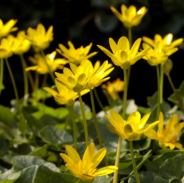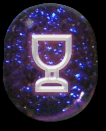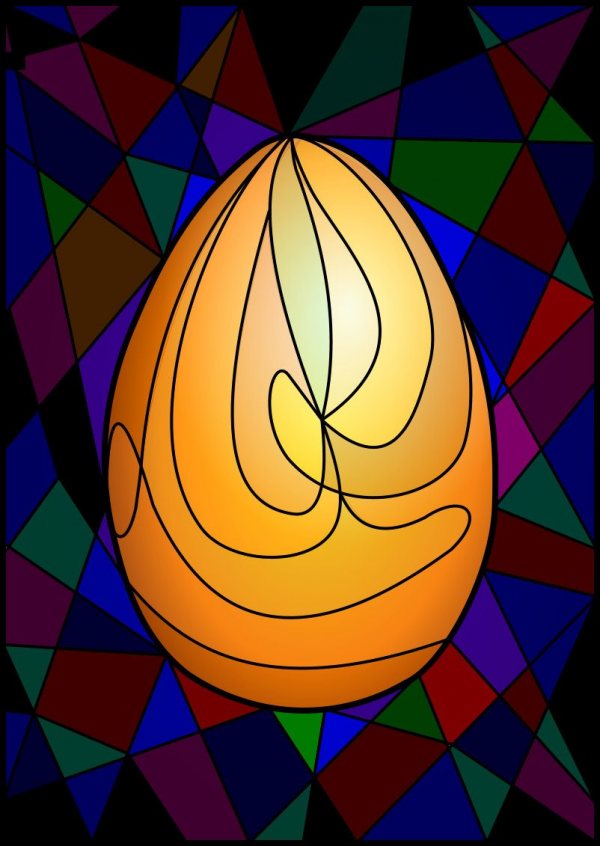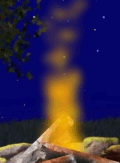Celandine
The celandine flower is a conspicuous herald of spring, which is strikingly welcome to everyone living in the country throughout England, and a stranger to none. The Pilewort, or lesser Celandine, bespangles all our banks with its brilliant, glossy, golden stars, coming into blossom on or about March 7th, St. Perpetua's day.
Added Jun 17, 2010
| 9,215 Reads
They are a timely tocsin for five o'clock tea, because punctually at that hour they shut up their showy petals until 9.0 a.m. on the following morning. The well-known little herb, with its heart-shaped leaves, is a Ranunculus, and bears the affix ficaria from its curative value in the malady called ficus—a "red sore in the fundament". (Littleton, 1684). The popular title, Pilewort, from Pila, a ball, was probably first acquired because, after the doctrine of signatures, the small oval tubercles attached to its stringy roots were supposed to resemble and to cure piles. Nevertheless, it has been since proved practically that the whole plant, when bruised and made into an ointment with fresh lard, is really useful for healing piles; as likewise when applied to the part in the form of a poultice or hot fomentation. "There be those also who thinke that if the herbe be but carried about by one that hath the piles the paine forthwith ceaseth." It has sometimes happened that the small white tubercles collected about the roots of the plant, when washed bare by heavy rains, and lying free on the ground, have given rise to a supposed shower of wheat. After flowering the Pilewort withdraws its substance of leaf and stem into a small rounded tube underground, so as to withstand the heat of summer, and the cold of the subsequent winter. With the acrid juice of this herb, and of others belonging to the same Ranunculous order, beggars in England used to produce sores about their body for the sake of exciting pity, and getting alms. They afterwards cured these sores by applying fresh mullein leaves to heal them. The lesser Celandine furnishes a golden yellow volatile oil, which is readily converted into anemonic acid. Wordsworth specially loved this lesser Celandine, and turned his lyre to sing its praises:— "There is a flower that shall be mine, In token of which affectionate regard these flowers have been carved on the white marble of his tomb. The greater Celandine, or Coeli donum (Chelidonium majus), though growing freely in our waste places and hedgerows, is, perhaps, scarcely so well known as its diminutive namesake. Yet most persons acquainted with our ordinary rural plants have repeatedly come across this conspicuous herb, which exudes a bright yellow juice when bruised. It has sharply cut vivid leaves of a dull green, with a small blossom of brilliant yellow, and is not altogether unlike a buttercup, though growing to the height of a couple of feet. But this Celandine belongs to the Poppy tribe, whilst the Buttercup is a Ranunculus. The technical name of the greater Celandine (Chelidonium) comes from the Greek word Chelidon, a swallow, because of an ancient tradition that the bird makes use of this herb to open the eyes of its young, or to restore their sight when it has been lost:— "Caecatis pullis hâc lumina mater hirundo The ancients entertained a strong belief that birds are gifted with a knowledge of herbs; the woodpecker, for instance, seeking out the Springwort to remove obstructions, and the linnet making use of the Eyebright to restore its vision. Queen Elizabeth in the forty-sixth year of her age was attacked with such a grievous toothache that she could obtain no rest by night or day because of the torture she endured. The lords of her council decided on sending for an "outlandish physician" named Penatus, who was famous for curing this agonising pain. He advised that when all was said and done, if the tooth was hollow, it were best to have it drawn; but as Her Majesty could not bring herself to submit to the use of surgical instruments, he suggested that the Chelidonius major—our greater Celandine— should be put into the tooth, and this stopped with wax, which would so loosen the tooth that in a short time it might be pulled out with the fingers. Aylmer, Bishop of London, tried to encourage the Queen by telling her that though he was an old man, and had not many teeth to spare, she should see a practical experiment made on himself. Thereupon he bade the surgeon who was in attendance extract one of his teeth in Her Majesty's presence. This plant, the Chelidonium majus, is still used in Suffolk for toothache by way of fomentation. It goes also by the name of "Fenugreek" (Foenum Groecum), Yellow Spit, Grecian Hay, and by that of Tetterwort. The root contains chemically "chelidonin" and "sanguinarin." On the doctrine of signatures the herb, because of its bright orange-coloured juice, was formerly believed to be curative of jaundice. A medicinal tincture made from the entire plant with spirit of wine is at the present time held in high esteem by many physicians for overcoming torpid conditions of the liver. Eight or ten drops of this tincture, or of the fresh juice of the plant, may be given for a dose three times in the day in sweetened water when bilious yellowness of the skin is present, with itching, and with clayey stools, dark thick urine, constipation, and a pain in the right shoulder; also for neuralgia of the head and face on the right side. It is certainly remarkable that though the fanciful theory of choosing curative plants by their signatures has been long since exploded, yet doctors of to-day select several yellow medicines for treating biliary disorders—to wit, this greater Celandine with its ochreous juice; the Yellow Barberry; the Dandelion; the Golden Seal (Hydrastis); the Marigold; Orange; Saffron; and Tomato. Animals poisoned by the greater Celandine have developed active and pernicious congestion of the lungs and liver. Clusius found by experience that the juice of the greater Celandine, when squeezed into small green wounds of what sort so ever, wonderfully cured them. "If the juice to the bigness of a pin's head be dropped into the eye in the morning in bed, it takes away outward specks, and stops incipient suffusions." Also if the yellow juice is applied to warts, or to corns, first gently scraped, it will cure them promptly and painlessly. The greater Celandine is by genus closely allied to the horned Poppy which grows so abundantly on our coasts. Its tincture given in small doses proves of considerable service in whooping-cough when very spasmodic. Curious remedies for this complaint have found rustic favour: in Yorkshire owl broth is considered to be a specific; again in Gloucestershire a roasted mouse is given to be eaten by the patient; and in Staffordshire the child is made to look at the new moon whilst the right hand of the nurse is rubbed up and down its bare belly. Wart-wortWART-WORT, OR WART-WEED. This name has been commonly applied to the Petty Spurge, or to the Sun Spurge, a familiar little weed growing abundantly in English gardens, with umbels of a golden green colour which "turn towards the sun." Its stem and leaves yield, when wounded, an acrid milky juice which is popularly applied for destroying warts, and corns. But our Greater Celandine or Swallow-wort is better known abroad as the Wart-wort: and its sap is widely given in Russia for the cure, not only of warts, but likewise of cancerous outgrowths, whether occurring on the skin surface, or assailing membranes inside the body. Conclusive evidence has been adduced of cancerous disease within the gullet and the stomach--as well as on the external skin--being healed by this herb. The wartworts sap, or juice, contains chemically, "chelidonine," and "sanguinarine," which latter principle (obtained heretofore from the Canadian "blood root"), is of long established repute for repressing fungoid granulations of indolent ulcers, when powdered over them, and of quickly advancing their cure. Each principle exercises a narcotic influence on the nervous system, and will, thereby, relieve spasmodic coughs. Healthy provers have taken the fresh juice of the Greater Celandine in doses of from twenty to two hundred drops, at repeated intervals; the results of the larger portions being drastic purgation, with persistent nervous torpor, and with an outbreak on the skin of irritating, sore, itching eruptions. In some of the provers active inflammatory congestion of the right lung ensued, with turgidity of the liver. The root beaten into a conserve with sugar will operate by stool, and by urine. For cancerous excrescences from five to ten drops of the fresh juice, or of the mother tincture (H.) should be given steadily three times a day, this quantity being reduced if it should move the bowels too freely. Some of the sap, or tincture, should be also used outwardly as a lotion, either by itself, or diluted with an equal quantity of cold water.
Added Jun 17, 2010
| 9,215 Reads
Share The Magic ...
The GoE MONEY!!! Course - A Course In Real MONEY MAGIC!
|





















